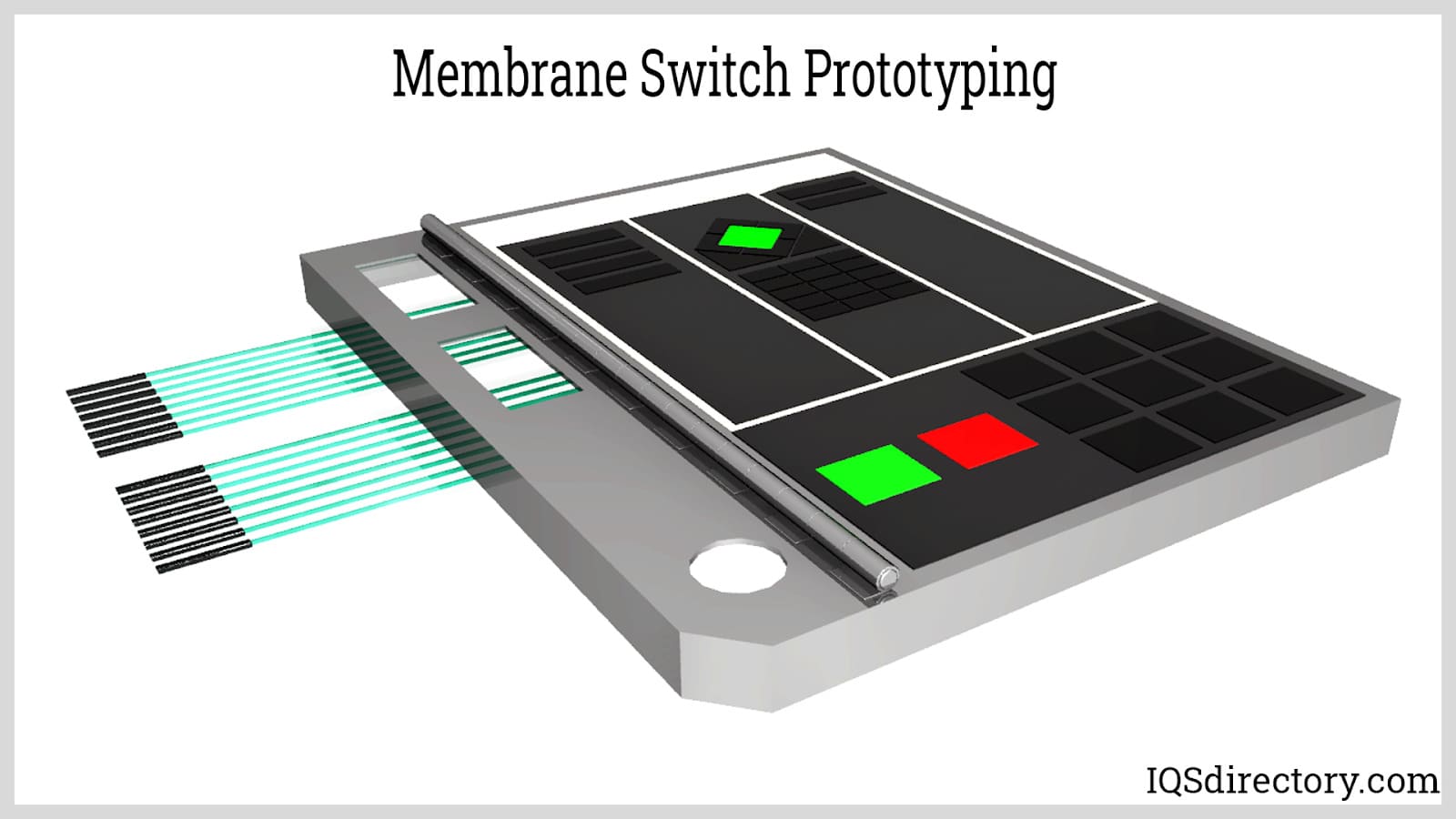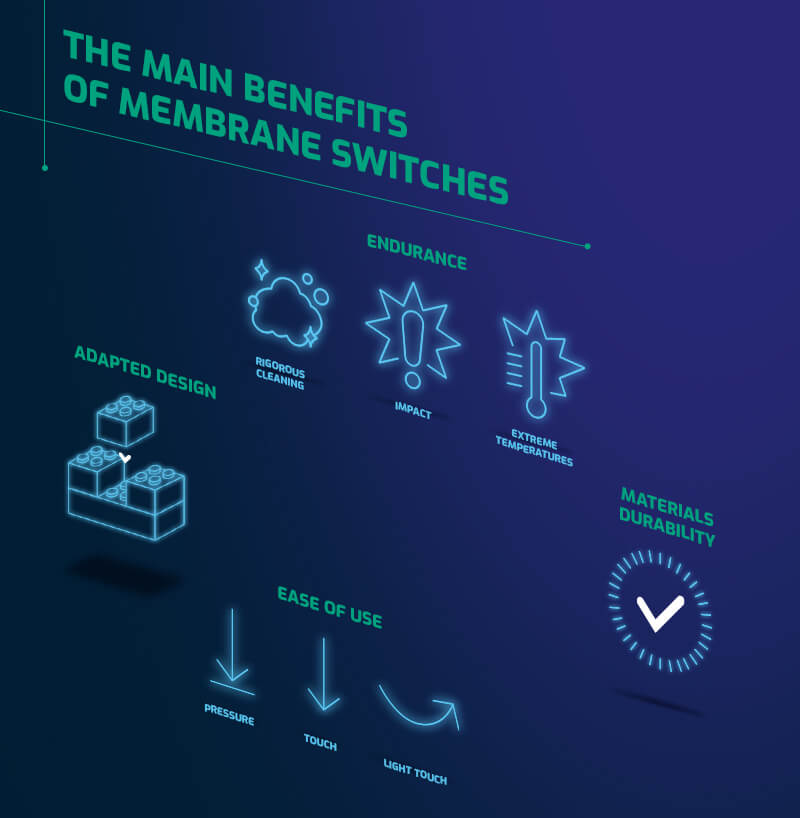Everything About Membrane Switch: A Comprehensive Overview for Beginners
Membrane buttons are crucial parts in contemporary electronics, using a distinct interface for user interaction - membrane switch. Their split construction, consisting of overlays and conductive traces, supplies functionality and durability. Unlike typical mechanical buttons, membrane buttons provide a streamlined design and customizable alternatives. Understanding their crucial features and advantages can transform item design. The intricacies of their application and layout considerations necessitate further exploration.
What Is a Membrane layer Change?
A membrane layer switch is a kind of electric switch that is composed of an adaptable membrane layered over a printed circuit board. This layout permits a small and sleek user interface, usually utilized in various digital devices. Membrane switches are typically located in consumer home appliances, clinical devices, and commercial machinery because of their toughness and resistance to ecological factors.The construction normally consists of multiple layers, such as graphic overlays and adhesive backing, which give responsive feedback and protect the circuitry beneath. The procedure of a membrane layer button is started when stress is put on the surface, completing an electrical circuit.These switches are valued for their flexibility, making it possible for personalized layouts and published graphics that accommodate particular interface. Their inconspicuous nature lowers space demands, making them suitable for applications where standard switches might not fit. In general, membrane layer buttons supply a useful and visual remedy for modern-day electronic tools.
Key Components of Membrane Switches Over
Membrane layer switches make up a number of key components that add to their capability and efficiency. The leading layer, understood as the overlay, provides the interface and is often printed with graphics or icons. Below the overlay lies a spacer layer, which divides the conductive components and stops unintended activation. The next essential component is the visuals layer, which enhances visual appeals and assures the durability of the design.Conductive traces, generally made from products like silver or carbon, are printed on the circuit layer. When stress is related to the overlay, these traces enter into contact, finishing the circuit. Additionally, a support layer uses structural assistance and can be made from materials such as polyester or polycarbonate. With each other, these components create a reliable, straightforward interface appropriate for various applications, from household devices to commercial devices. Recognizing these components is vital for any person thinking about membrane switch innovation.
Exactly How Membrane Switches Job
Comprehending exactly how membrane layer changes feature is essential for valuing their widespread usage in numerous gadgets. A membrane layer switch operates via a collection of layers, consisting of a graphic overlay, spacer, and a circuit layer. When pressure is put on the overlay, it compresses the spacer layer, enabling the circuit layer to make contact and finish an electric circuit. This action sends out a signal to the tool, prompting a feedback, such as activating a light or activating a function.Membrane switches over can be made with various functions, consisting of tactile comments, backlighting, and personalized graphics, boosting user interaction. Their construction enables for a closed style, shielding the internal elements from dirt, wetness, and impurities. This durability makes them appropriate for varied applications, from customer electronic devices to commercial tools. Overall, the simplicity and efficiency of membrane switches contribute to their appeal in modern-day innovation.
Benefits of Membrane Switches Mechanical Buttons
While mechanical buttons have actually long been a staple in lots of gadgets, membrane layer switches deal distinctive benefits that make them progressively appealing. One significant advantage is their slim account, permitting even more portable styles and higher flexibility in item growth. In addition, membrane layer switches feature an uniform surface, which enhances visual charm and simplifies cleaning, making them appropriate for environments where health is critical.Another advantage is their resistance to dirt and wetness. Unlike mechanical buttons, which can be jeopardized by environmental elements, membrane layer buttons offer a sealed user interface that secures against contaminants - membrane switch. Membrane layer switches normally have a longer lifespan due to less moving components, resulting in improved longevity and reliability.Cost-effectiveness is likewise a significant benefit, as membrane layer switches can be created in mass with reduced manufacturing expenses. These variables combine to place membrane buttons as a practical option to conventional mechanical choices in numerous applications
Common Applications of Membrane Layer Switches Over
Membrane layer switches are commonly made use of in various markets, especially in customer electronic devices and industrial control panels. In customer gadgets, they give a sleek, easy to use user interface, while in industrial setups, they enhance sturdiness and capability. Recognizing these applications highlights the adaptability and practicality of membrane switches in contemporary innovation.
Consumer Electronics Tools
As customer electronic devices remain to develop, membrane layer buttons have actually come to be a popular selection for a selection of tools as a result of their versatility and smooth layout. These buttons are generally located in smart devices, tablets, and push-button controls, where area is restricted and aesthetics matter. Their low profile and adjustable designs allow manufacturers to produce easy to use interfaces that enhance the overall user experience. In addition, membrane buttons are usually made use of in devices such as microwaves and coffee machine, offering user-friendly control alternatives while resisting moisture and dirt. The durability and reliability of membrane changes make them appropriate for everyday consumer items, making certain durability and constant performance. On the whole, their assimilation in customer electronic devices reflects a mix of performance and contemporary style.
Industrial Control Panels
The applications of membrane switches over prolong past customer electronic devices, discovering significant usage in industrial control panels. These buttons are preferred for their sturdiness and resistance to harsh settings, making them ideal for making and process control setups. They supply a reputable user interface for operators to manage equipment, screen processes, and adjust setups. Membrane layer switches can be tailored to fit particular functional needs, including features like backlighting and responsive comments, boosting individual experience. Their inconspicuous design permits assimilation into different equipment, while their capability to endure spills, dirt, and extreme temperature levels warranties longevity. On the whole, membrane buttons add to safe and reliable operation in industrial applications, demonstrating their flexibility and efficiency sought after settings.
Considerations for Designing Membrane Layer Switches
When creating membrane layer buttons, selecting the appropriate materials is vital to ensure durability and performance. Additionally, comprehending layer setup methods can substantially affect the switch's efficiency and individual experience. These factors to consider play a vital role in producing efficient and trustworthy membrane switch designs.
Material Selection Importance
Material choice plays a crucial duty in the layout and capability of membrane layer buttons. The picked products straight impact the switch's longevity, responsive feedback, and general aesthetic. Secret factors to consider consist of the substrate, which should supply architectural honesty while permitting for adaptability, and the graphic overlay, which needs to be resistant to use and environmental factors. Conductive products ought to assure reliable electric efficiency, while adhesives should use strong bonding without jeopardizing the switch's procedure. Furthermore, compatibility with manufacturing processes and end-user settings is crucial; materials must endure varying temperatures, moisture levels, and chemical direct exposure. Inevitably, ideal material selection not just enhances the membrane switch's performance but also adds to its longevity and individual satisfaction, making it a vital aspect of the layout process.

Layer Configuration Techniques

Often Asked Questions
The Length Of Time Do Membrane Switches Over Normally Last?
Membrane switches usually have a life expectancy of 1 to 5 million cycles, relying on use and environmental problems. Elements such as style quality and operating frequency significantly affect their resilience and general efficiency longevity.

Can Membrane Layer Switches Over Be Personalized for Particular Layouts?
Membrane layer buttons can certainly be customized to accommodate details designs, enabling varied my review here forms, colors, and capabilities. This convenience enables manufacturers to customize these switches to meet one-of-a-kind aesthetic and operational requirements properly.
What Materials Are Used in Membrane Layer Switch Over Building And Construction?
Membrane buttons are normally constructed utilizing materials such as polyester, polycarbonate, and sticky layers. These products offer longevity, resistance, and versatility to ecological elements, making certain the switches operate efficiently in numerous applications and problems.
Are Membrane Switches Resistant or water resistant to Dampness?
Membrane layer buttons can be made to be moisture-resistant, utilizing specialized products and coverings. Their water resistant capabilities depend on building high quality and particular applications, making it necessary to analyze needs for perfect performance in different atmospheres.
How Are Membrane Switches Repaired if Damaged?
Repairing damaged membrane layer switches over commonly entails replacing the affected layer or circuit. Technicians may additionally use conductive sticky or make use of specialized fixing packages, making sure performance is brought back without complete replacement of the entire button setting up. Unlike standard mechanical switches, membrane layer switches offer a streamlined style and customizable alternatives. A membrane layer button is a type of electrical button that consists of a flexible membrane layer layered over a printed circuit board. The procedure of a membrane layer switch is initiated when pressure is applied to the surface area, finishing an electrical circuit.These buttons are valued for their adaptability, allowing personalized styles and printed graphics that provide to certain user interfaces. While mechanical buttons have actually long been a staple in lots of devices, membrane layer switches over deal distinctive advantages that why not find out more make them significantly appealing. Membrane buttons normally have a longer life-span due to fewer moving parts, resulting in enhanced toughness and reliability.Cost-effectiveness is also a remarkable benefit, as membrane layer switches can be created in mass with lower production prices.
Comments on “How membrane switch is a game changer in aerospace control systems”